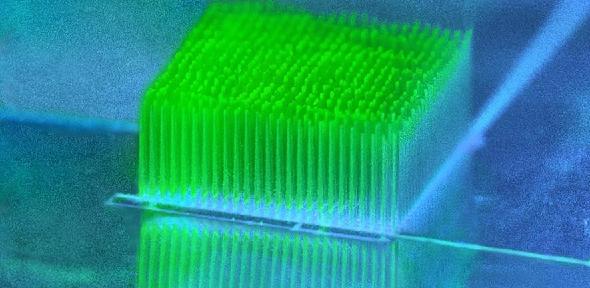
Researchers have made tiny ‘skyscrapers’ for communities of bacteria, helping them to generate electricity from just sunlight and water.
The researchers, from the University of Cambridge, used 3D printing to create grids of high-rise ‘nano-housing’ where sun-loving bacteria can grow quickly. The researchers were then able to extract the bacteria’s waste electrons, left over from photosynthesis, which could be used to power small electronics.
Other research teams have extracted energy from photosynthetic bacteria (or cyanobacteria), but the Cambridge researchers have found that providing them with the right kind of home increases the amount of energy they can extract by over an order of magnitude. The approach is competitive against traditional methods of renewable bioenergy generation and has already reached solar conversion efficiencies that can outcompete many current methods of biofuel generation.
"Our approach is a step towards making even more sustainable renewable energy devices for the future” Dr Jenny Zhang, Yusuf Hamied Department of Chemistry
Their results, reported in the journal Nature Materials, open new avenues in bioenergy generation and suggest that ‘biohybrid’ sources of solar energy could be an important component in the zero-carbon energy mix.
Current renewable technologies, such as silicon-based solar cells and biofuels, are far superior to fossil fuels in terms of carbon emissions, but they also have limitations, such as a reliance on mining, challenges in recycling, and a reliance on farming and land use, which results in biodiversity loss.
Zhang and her colleagues from the Department of Biochemistry and the Department of Materials Science and Metallurgy are working to rethink bioenergy into something that is sustainable and scalable. In order to grow, cyanobacteria need lots of sunlight – like the surface of a lake in summertime. And in order to extract the energy they produce through photosynthesis, the bacteria need to be attached to electrodes.
The Cambridge team 3D-printed custom electrodes out of metal oxide nanoparticles that are tailored to work with the cyanobacteria as they perform photosynthesis. The electrodes were printed as highly branched, densely packed pillar structures, like a tiny city. Zhang’s team developed a printing technique that allows control over multiple length scales, making the structures highly customisable, which could benefit a wide range of fields. Once the self-assembling cyanobacteria were in their new ‘wired’ home, the researchers found that they were more efficient than other current bioenergy technologies, such as biofuels.
The research was supported in part by the Biotechnology and Biological Sciences Research Council, the Cambridge Trust, the Isaac Newton Trust and the European Research Council. Jenny Zhang is BBSRC David Phillips Fellow in the Department of Chemistry, and a Fellow of Corpus Christi College, Cambridge.
Read the full University of Cambridge article.
Xiaolong Chen et al. ‘3D-printed hierarchical pillar array electrodes for high performance semi-artificial photosynthesis.’ Nature Materials (2022). DOI: 10.1038/s41563-022-01205-5
Image credit: 3D-printed custom electrodes, by Gabriella Bocchetti

